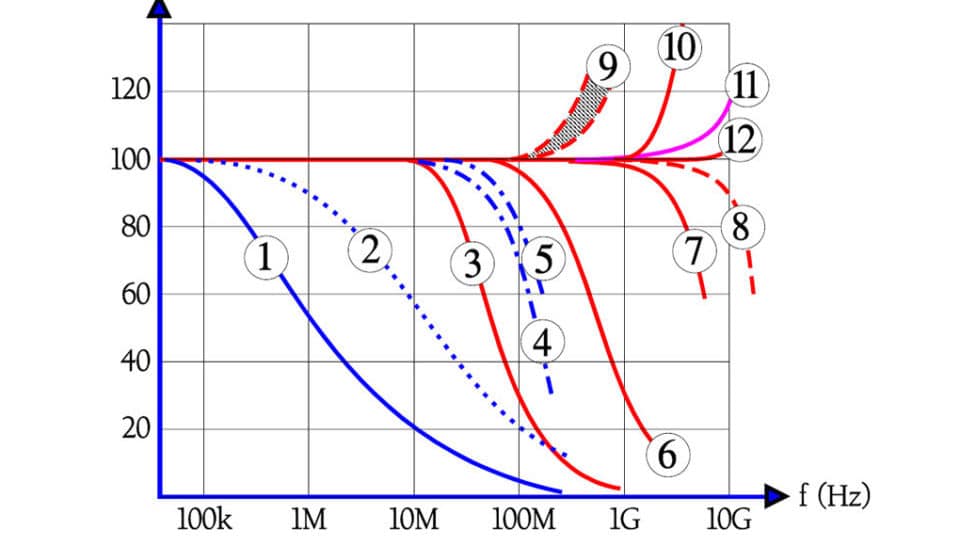R 1.11 VOLTAGE DEPENDENCE
If we apply a voltage on a resistor, it’s resistance will drop slightly in certain types. Therefore, the resistance change is negative.
The change per volt of applied voltage is called voltage coefficient, VC, and is expressed in %/V or better, μV/V. The coefficient is determined not only by the resistive material but also by the dimensions, i.e., the electrical field strength, and the time of applied voltage. Thus, MIL-STD-202, Method 309 prescribes measurements when the voltage is applied intermittently for less than 0.5 seconds. Two measurements is performed: the resistance (r) at 0.1 x rated voltage (VR) and the resistance (R) at 1.0 x VR. The voltage coefficient, VC, then is computed as:
………………[R1-13]
If we disregard pure metallic resistive elements common values of the voltage coefficient are between –10 and –100 μV/V. The voltage dependence is negligible for resistance values below 1000 ohms.
An evident voltage dependence combined with AC voltages will cause distortion and a third harmonic attenuation.
R 1.12 FREQUENCY DEPENDENCE
A resistor has a certain parasitic degree of both capacitance and inductance. Between the turns there is a certain capacitive connection. Inductance appears already in a straight lead, approximately 1 nH/mm of length but is amplified by the coil action from windings and spiraled patterns. In carbon composition resistors only capacitance emanating from the multitude of parallel current paths manifests itself.
Figure R1-17 shows the equivalent circuit being simplified to models for high and low resistance values.
The frequency dependence of resistance decreases if the resistors:
- have small dimensions.
- have a low resistance value.
- are of a thin film design. Even a thick film design is favorable.
- have as short a lead as possible, like SMDs.
- are geometrically even, i.e., without sudden geometrical changes along the resistor body.
How the frequency dependence may influence the impedance is shown in Figure R1-18.
- Carbon composition, ¼ W, 1 MW.
- Carbon composition, ¼ W, 100 kW.
- Chip, thick film, EIA size 0603, 100 kW; c » 0.05 pF; L » 0.4 nH.
- Metal glaze or metal film, DIN size 0207, 100 kW; c » 0.4 pF.
- MELF, DIN size 0204, 10 kW.
- Chip, thick film, EIA size 0603, 10 kW; c » 0.05 pF; L » 0.4 nH.; Chip, metal foil, EIA size 1210, 10 kW.
- Chip, thick film, EIA size 0603, 1 kW; c » 0.05 pF; L » 0.4 nH.
- MELF, DIN size 0102, high frequency design, 10 W; c » 0.035 pF; L » 0.8 nH.
- MELF, DIN size 0204, 10 W.
- Chip, thick film, EIA size 0603, 10 W; c » 0.05 pF; L » 0.4 nH.
- Chip, thin film, EIA size 0603, 100 W; c » 0.035 pF; L » 1.2 nH.
- Chip, thick film, EIA size 0603, 100 W; c » 0.05 pF; L » 0.4 nH.
The examples in Figure R1-18 represent a guide only. They are taken from major manufacturers’ data sheet. Note how the resistance value of an otherwise equivalent component influences the parameters: No. 3, 6, 7, 10 and 12. Another example, No. 8, shows a MELF component that, by means of a specific spiraling technique, is given excellent high frequency characteristics. Generally the frequency dependence of the different resistor materials can be divided into three groups:
| Technology | Frequency Dependence |
| Carbon composition | high |
| Metal glaze, cermet, thick film | moderate to low |
| Metal film, metal oxide and carbon film | low |
Film resistors may approximately be classified as follows:
- values < 100Ω are inductive.
- values between 100 and 470Ω are practically true resistive.
- values above 470Ω are capacitive.
ABC of CLR: Chapter R Resistors
Voltage and Frequency Dependence
EPCI licenced content by:
[1] EPCI European Passive Components Institute experts original articles
[2] CLR Passive Components Handbook by P-O.Fagerholt*
*used under EPCI copyright from CTI Corporation, USA
This page content is licensed under a Creative Commons Attribution-Share Alike 4.0 International License.
see the previous page:
< Page 4 >
see the next page:
